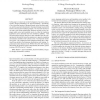153
Voted
KDD
2012
ACM
13 years 2 months ago
2012
ACM
Multi-label learning arises in many real-world tasks where an object is naturally associated with multiple concepts. It is well-accepted that, in order to achieve a good performan...
149
Voted
KDD
2012
ACM
13 years 2 months ago
2012
ACM
Multi-instance multi-label learning (MIML) is a framework for supervised classification where the objects to be classified are bags of instances associated with multiple labels....
116
Voted
IUI
2012
ACM
13 years 8 months ago
2012
ACM
One Feature (1F) is a simple and intuitive pruning strategy that reduces considerably the amount of computations required by Nearest-Neighbor gesture classifiers while still pres...
112
click to vote
IACR
2011
14 years 1 days ago
2011
The KeeLoq cipher is used in many wireless car door systems and garage openers. Recently the algorithm was studied and several attacks have been published. When a random seed is no...
228
Voted
ECWEB
2011
Springer
14 years 5 days ago
2011
Springer
Context aware recommender systems (CARS) adapt to the specific situation in which the recommended item will be consumed. So, for instance, music recommendations while the user is ...
159
Voted
IUI
2011
ACM
14 years 3 months ago
2011
ACM
Protractor 3D is a gesture recognizer that extends the 2D touch screen gesture recognizer Protractor [8] to 3D gestures. It inherits many of Protractor’s desirable properties, s...
104
click to vote
ICASSP
2011
IEEE
14 years 4 months ago
2011
IEEE
In this paper we report our recent development of an end-to-end integrative design methodology for speech translation. Specifically, a novel decision function is proposed based o...
106
Voted
INFFUS
2010
14 years 11 months ago
2010
- Many exciting, emerging applications require that a group of agents share a coherent view of the world given spatial distribution, incomplete and uncertain sensors, and communica...
96
Voted
CAD
2004
Springer
15 years 8 days ago
2004
Springer
Heterogeneous objects are objects composed of different constituent materials. In these objects, multiple desirable properties from different constituent materials can be synthesi...
106
click to vote
RAS
2006
15 years 9 days ago
2006
This paper presents a design methodology for a class of behaviour-based control systems, arguing its potential for application to safety critical systems. We propose a formal basi...





